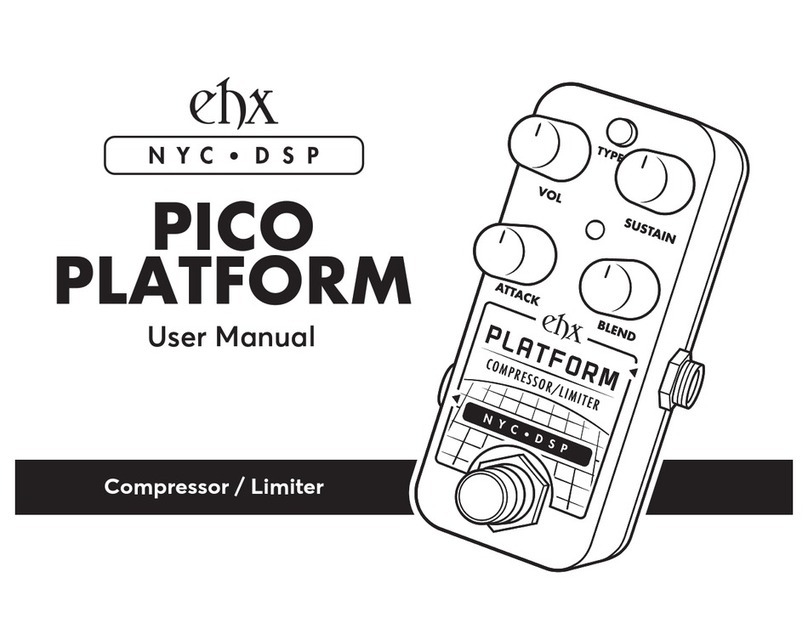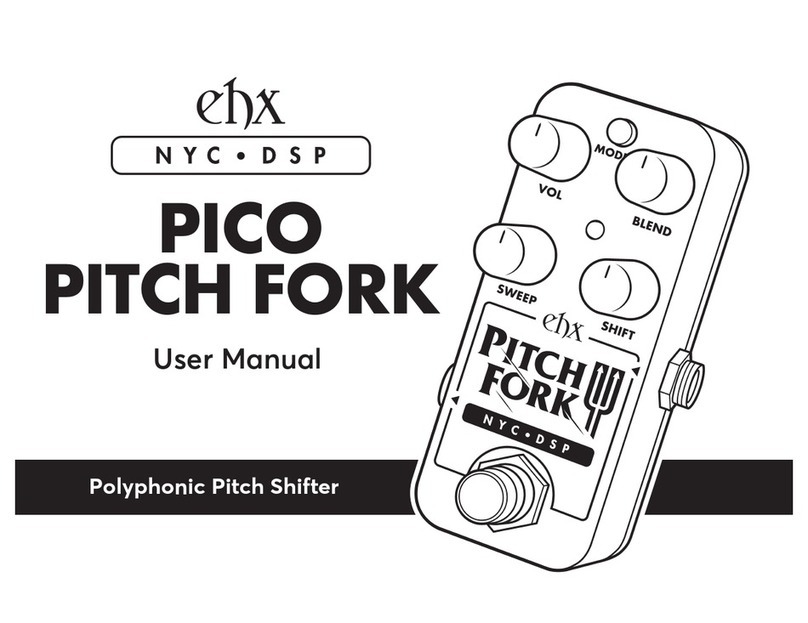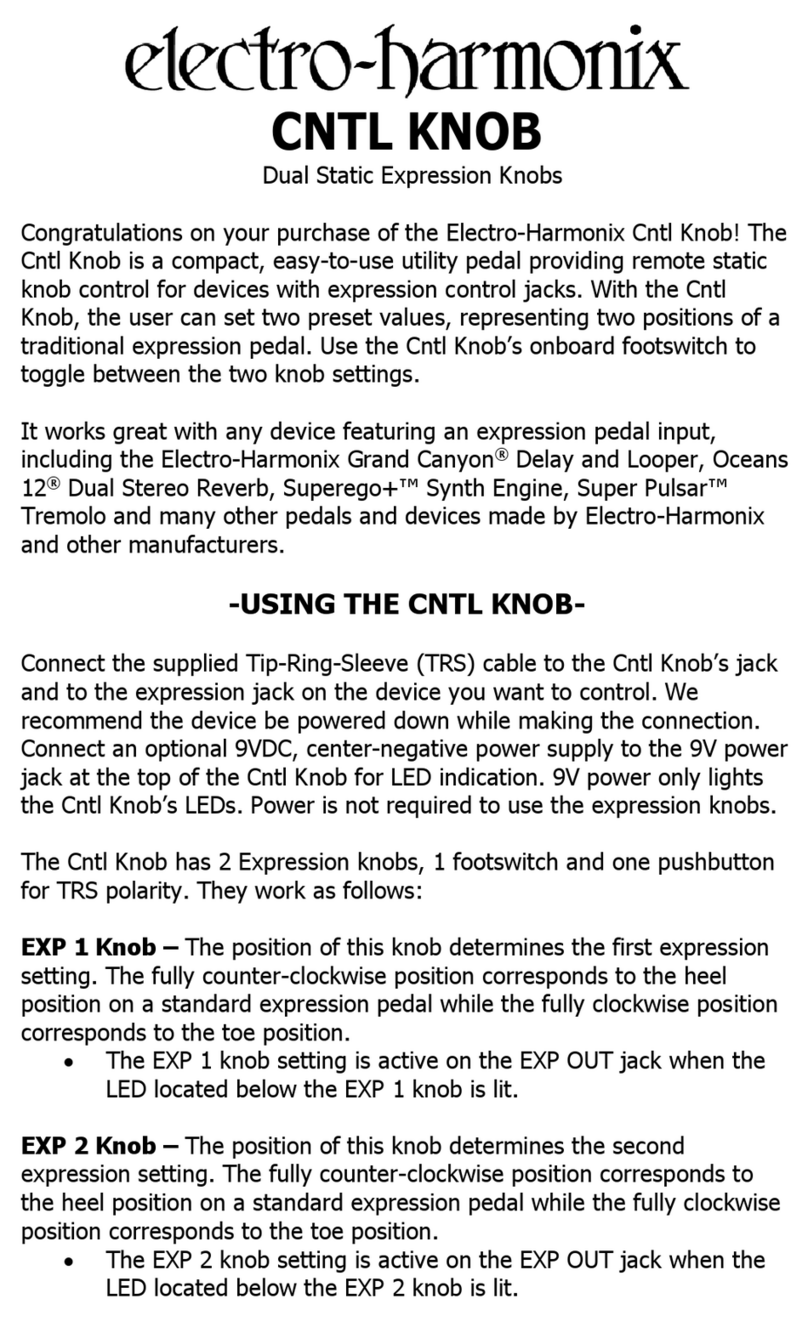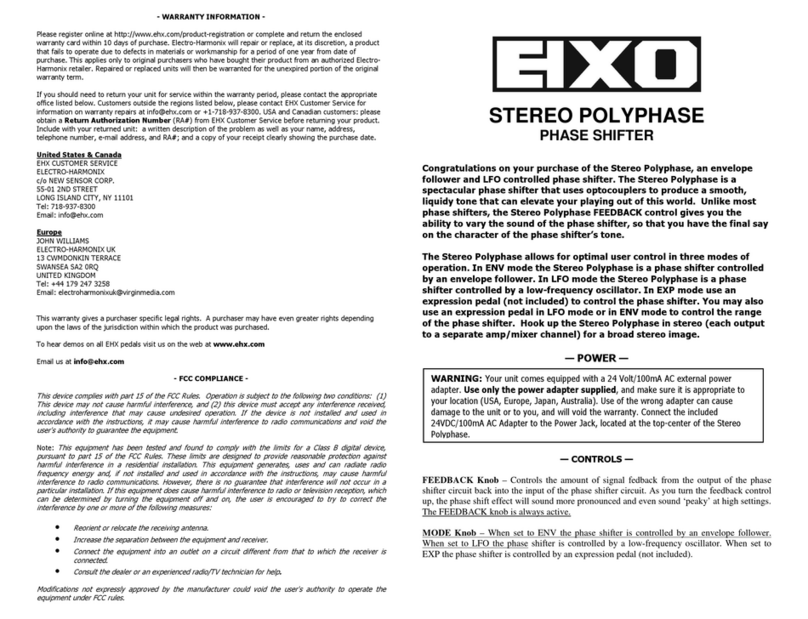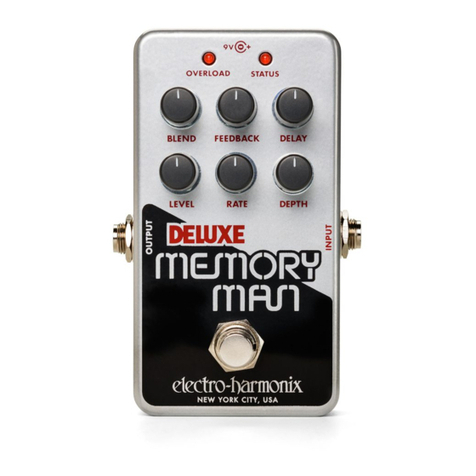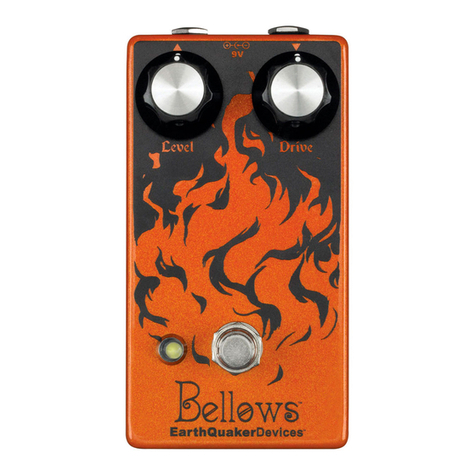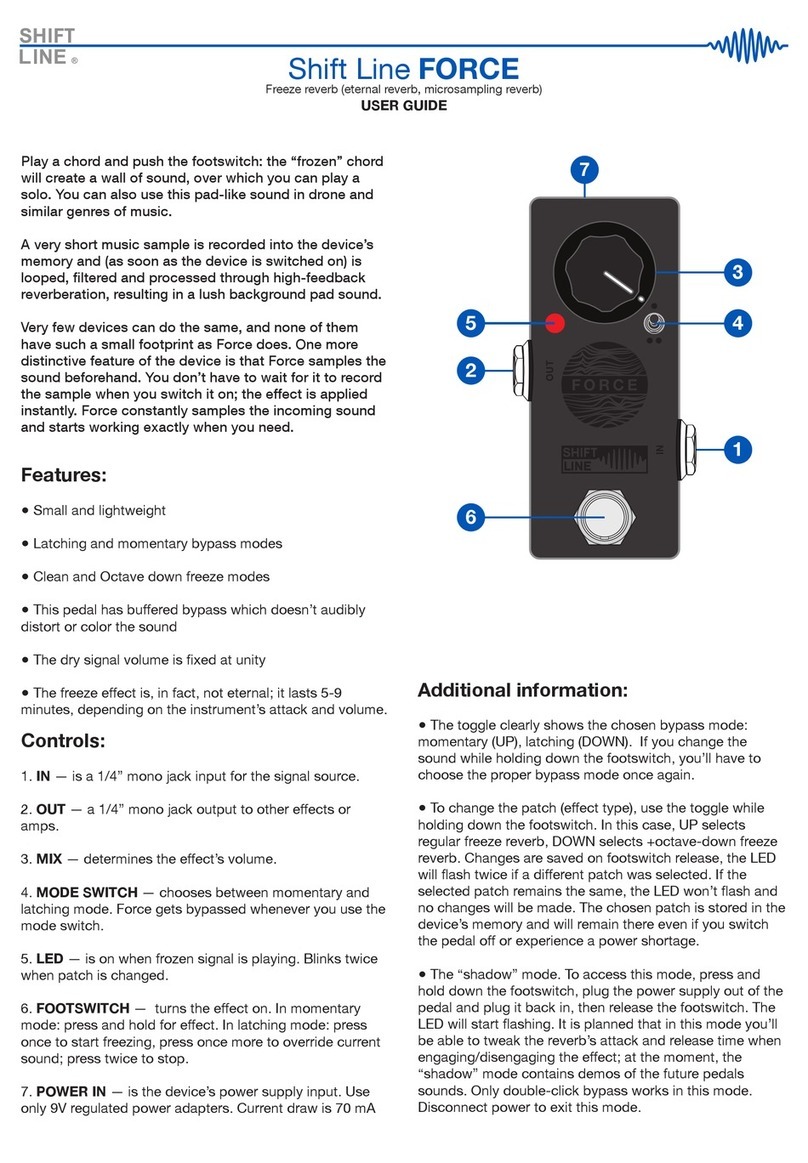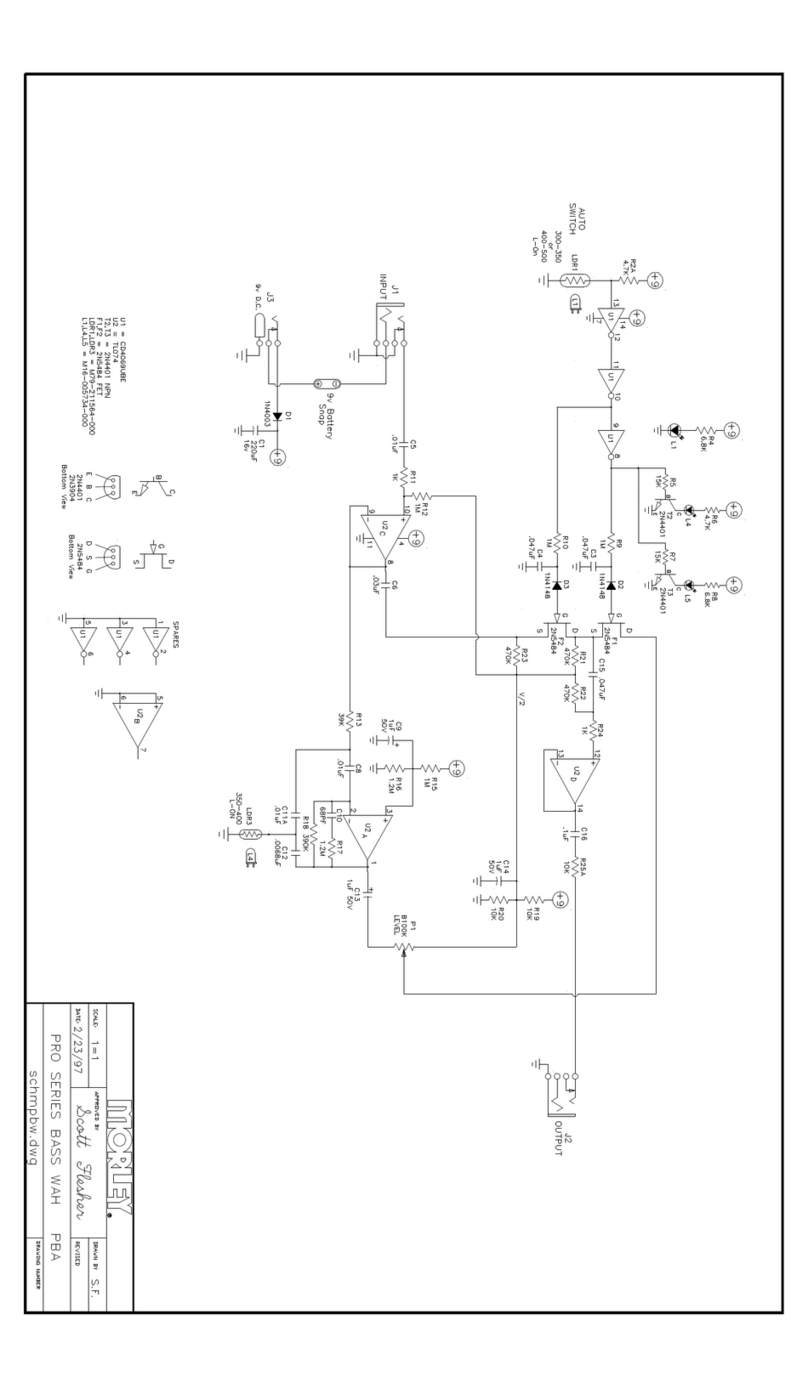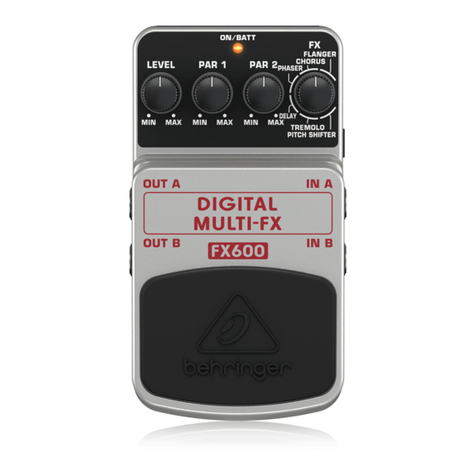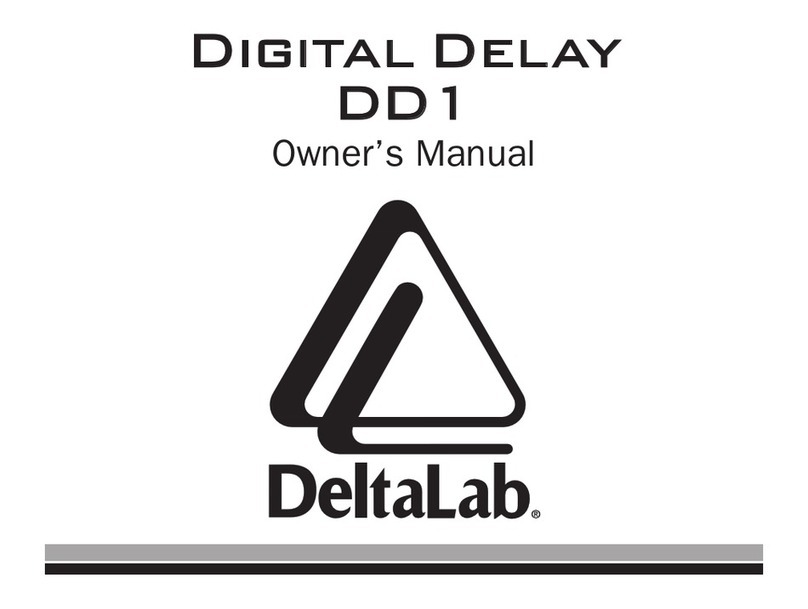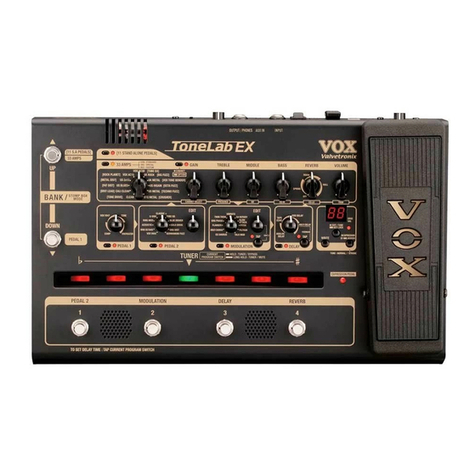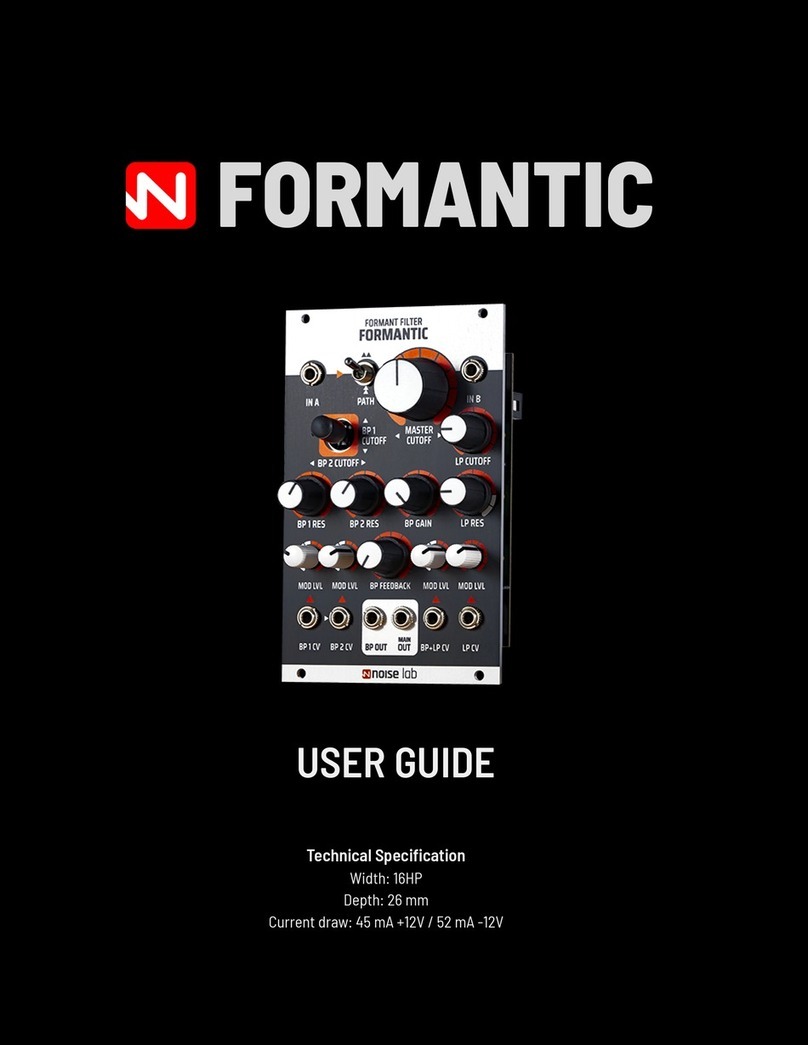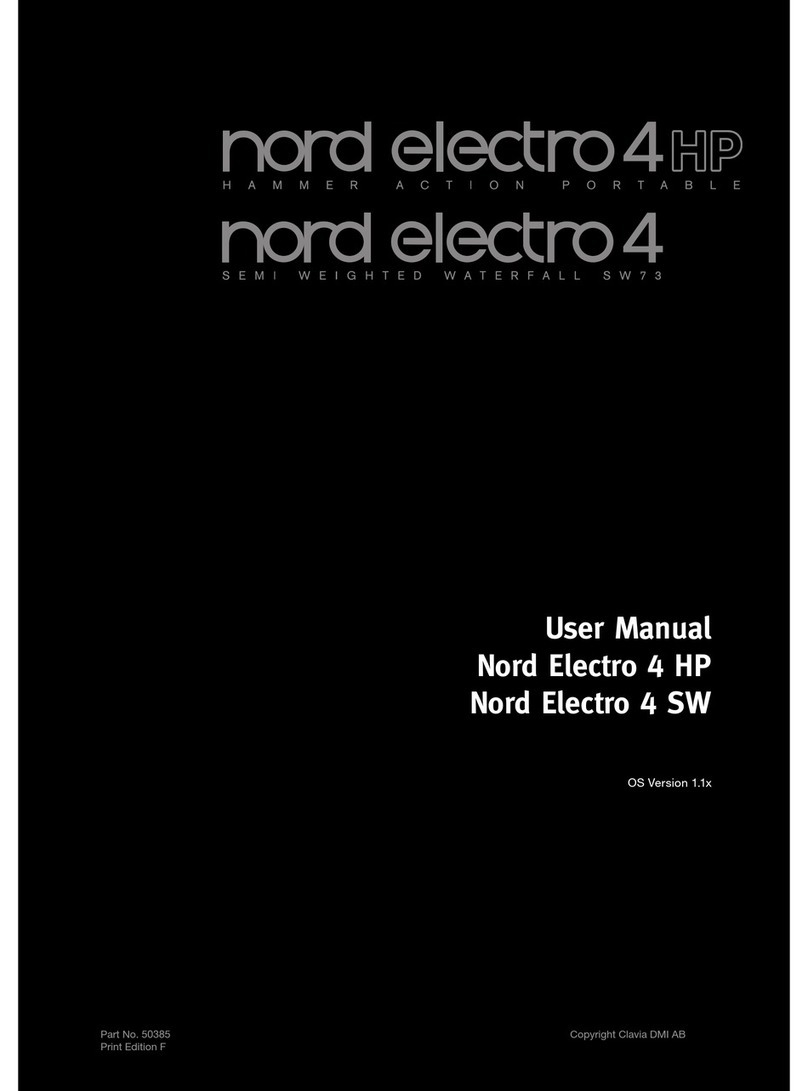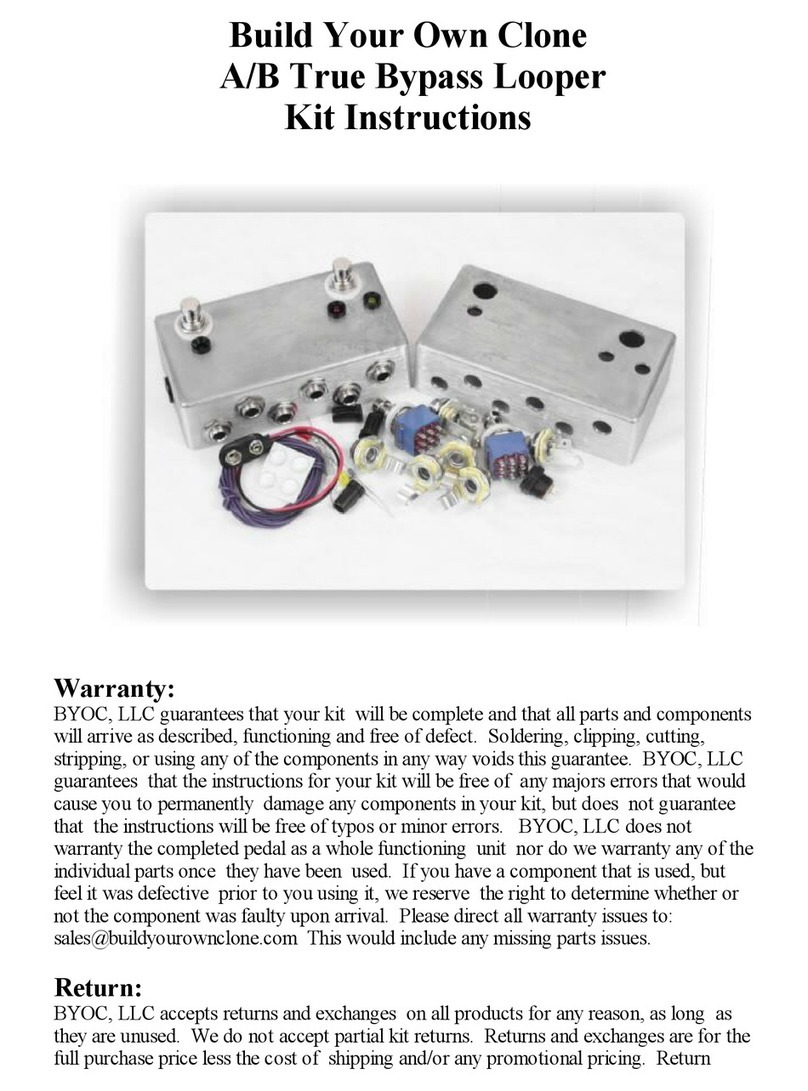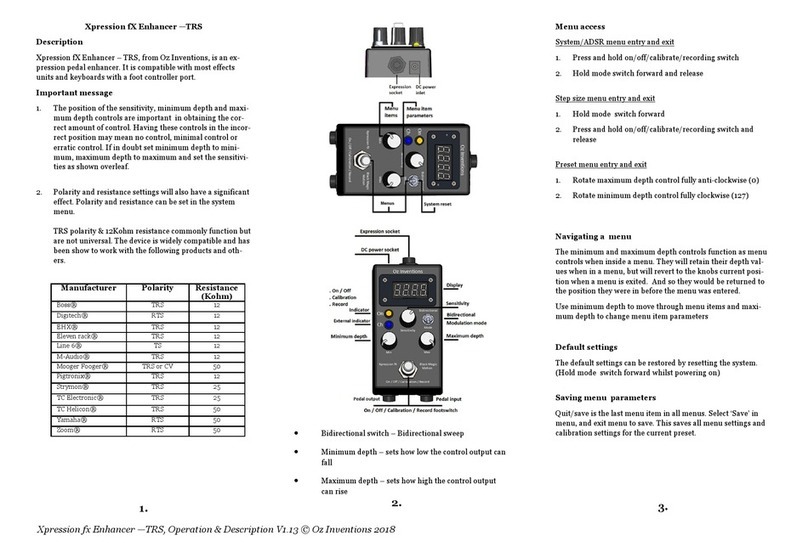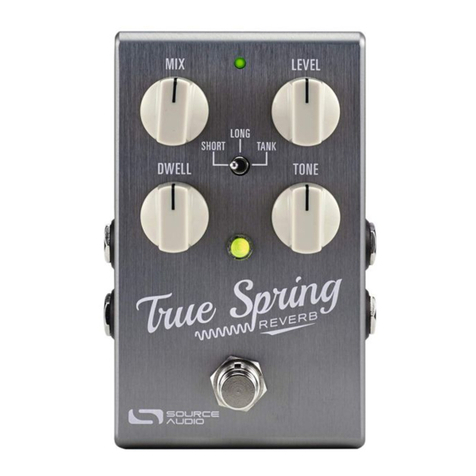EHX POG 2 User manual

- WARRANTY INFORMATION -
Please register online at http://www.ehx.com/product-registration or complete and return the enclosed
warranty card within 10 days of purchase. Electro-Harmonix will repair or replace, at its discretion, a product
that fails to operate due to defects in materials or workmanship for a period of one year from date of
purchase. This applies only to original purchasers who have bought their product from an authorized Electro-
Harmonix retailer. Repaired or replaced units will then be warranted for the unexpired portion of the original
warranty term.
If you should need to return your unit for service within the warranty period, please contact the appropriate
office listed below. Customers outside the regions listed below, please contact EHX Customer Service for
information on warranty repairs at i[email protected]om or +1-718-937-8300. USA and Canadian customers: please
obtain a Return Authorization Number (RA#) from EHX Customer Service before returning your product.
Include with your returned unit: a written description of the problem as well as your name, address,
telephone number, e-mail address, and RA#; and a copy of your receipt clearly showing the purchase date.
United States & Canada
EHX CUSTOMER SERVICE
ELECTRO-HARMONIX
c/o NEW SENSOR CORP.
47-50 33RD STREET
LONG ISLAND CITY, NY 11101
Tel: 718-937-8300
Europe
JOHN WILLIAMS
ELECTRO-HARMONIX UK
13 CWMDONKIN TERRACE
SWANSEA SA2 0RQ
UNITED KINGDOM
Tel: +44 179 247 3258
Email: electroharmonixuk@virginmedia.com
This warranty gives a purchaser specific legal rights. A purchaser may have even greater rights depending
upon the laws of the jurisdiction within which the product was purchased.
To hear demos on all EHX pedals visit us on the web at www.ehx.com
FCC COMPLIANCE
Note:
This equipment has been tested and found to comply with the limits for a Class B digital device,
pursuant to part 15 of the FCC Rules. These limits are designed to provide reasonable protection against
harmful interference in a residential installation. This equipment generates, uses and can radiate radio
frequency energy and, if not installed and used in accordance with the instructions, may cause harmful
interference to radio communications. However, there is no guarantee that interference will not occur in a
particular installation. If this equipment does cause harmful interference to radio or television reception, which
can be determined by turning the equipment off and on, the user is encouraged to try to correct the
interference by one or more of the following measures:
•
Reorient or relocate the receiving antenna.
•
Increase the separation between the equipment and receiver.
•
Connect the equipment into an outlet on a circuit different from that to which the receiver is
connected.
•
Consult the dealer or an experienced radio/TV technician for help.
Modifications not expressly approved by the manufacturer could void the user's authority to operate the
equipment under FCC rule
POG 2
Polyphonic Octave Generator
Congratulations on your purchase of the POG 2! The POG 2 is a Polyphonic Octave Generator that draws
its heritage from the now legendary POG, originally released in 2005 to worldwide acclaim. The POG 2 can
simultaneously generate multiple octaves from your input signal. Whether you play single notes, arpeggios
or full chords, the POG 2 will perfectly track every note you play. With the POG 2, you can mix together
your original "dry signal" with four different octaves: one octave above the original note, two octaves
above the original note, one octave below your original note and two octaves below the original note.
Additionally you can detune the two upper octaves, slow the attack on all voices including the dry signal
and process the overall tone through a low pass resonant filter with adjustable filter cutoff and selectable
Q. The POG 2 is fully programmable allowing you to store and load presets for performance and recording.
-CONTROLS-
DRY OUTPUT Slider
–Controls the output volume of your original DRY signal before it exits the POG 2.
The DRY OUTPUT volume will increase as its slider is pushed upward.
-2 OCTAVES Slider
–Controls the output volume of the signal 2 octaves below the input signal, which is
one quarter of the frequency of the input signal. As this slider is pushed upward, the volume of the -2
OCTAVE below the original pitch will increase. If you play a middle C note, this slider will control the
volume of the C note two octaves
below
middle C.
-1 OCTAVE Slider -
Controls the output volume of the signal 1 octave below the input signal, which is
half the frequency of the input signal. As this slider is pushed upward, the volume of the -1 OCTAVE below
the original pitch will increase. If you play a middle C note, this slider will control the volume of the C note
one octave
below
middle C.
+1 OCTAVE Slider
–Controls the output volume of the +1 octave signal. True to its name, the +1
OCTAVE signal is one octave above the original input signal. The +1 octave signal is twice the frequency of
the original input signal. The volume of the +1 OCTAVE will increase as this slider is pushed upward. If you
play a middle C note, this slider will control the volume of the C note one octave
above
middle C.
+2 OCTAVE Slider
–Controls the output volume of the +2 octave signal. The +2 octave signal is two
octaves above the original input signal or four times the frequency of the original input signal. As this slider
WARNING:
Use only the 9.6 VDC 200mA adapter the POG 2 comes supplied with. Do not
use any other adapters. Using other adapters, even those made by Electro-Harmonix, could
cause harm to the unit, the adapter or you. The POG 2 does not use batteries.

is pushed upward, the volume of the +2 OCTAVE signal will increase. If you play a middle C note, this
slider will control the volume of the C note two octaves
above
middle C.
ATTACK Slider -
Controls the attack envelope of all the octave voices. As the ATTACK slider is pushed
upward, the attack time increases producing a swell or reverse effect. Push the ATTACK slider down to its
minimum position to turn the attack effect off. The Attack effect will also work on the DRY signal whenever
the DRY FX LED is lit, no matter the color of the DRY FX LED.
LP FILTER Slider
–Controls the cutoff frequency of the Low Pass Filter. As the LP FILTER slider is pushed
upward, the cutoff frequency of the filter rises. The LP Filter control can be used to shape the tone of your
POG 2. All of the generated octave signals go through the LP Filter. The dry signal bypasses the LP Filter
when the DRY FX LED is off or lit red, the dry signal goes through the LP Filter when the DRY FX LED is lit
green or amber.
DETUNE Slider
–Controls the amount of detune applied to the +1 and +2 OCTAVE signals. As the
DETUNE slider is pushed up both the depth and rate of detune are increased. When DETUNE is pushed
down to its minimum position the detune function shuts off. The DETUNE slider will also effect the DRY
signal when the DRY FX LED is lit amber.
DRY FX Push-Button and LED
–The DRY FX Button cycles through four modes allowing the DRY signal
to either bypass or pass through the Attack, LP Filter and Detune effects. The modes are as follows:
LED State MODE
Off DRY bypasses all effects
RED DRY goes through Attack control, bypasses LP Filter and Detune
GREEN DRY goes through Attack and LP Filter, bypasses Detune
AMBER DRY goes through all three effects: Attack, LP Filter and Detune
Q Push-Button and LED
–The Q button and LED cycles through four levels of resonance or Q for the
Low Pass Filter. As the Q LED gets brighter the Q increases. LED off signifies the least amount of Q. The
brightest Q LED setting signifies the highest Q setting.
PRESET KNOB
–The white PRESET knob is used to select, load and save the 8 available presets. You can
load the selected preset by pressing and releasing the PRESET knob. To save a setting, first set the POG 2
to the sound you want to save, then turn the PRESET knob to the preset number you want to save your
sound into. Now press and hold the PRESET knob for 3 seconds. Release the knob after all of the Preset
LEDs stop blinking.
BYPASS FSW and LED
–The BYPASS FSW is used to toggle the POG 2 between effect mode and true
bypass mode. When the associated LED is lit, the POG 2 is in effect mode. When the LED is off the POG 2
is in true bypass mode.
PRESET FSW and LED –
The PRESET FSW can be used to cycle through and load the 8 available presets.
When a preset is loaded, the PRESET LED located near the PRESET FSW will light up solid. If a preset is
loaded and then a slider is moved or push-button is pressed, the PRESET LED will blink rapidly to indicate
that a parameter has been changed since the preset was loaded.
INPUT Jack
–This ¼” jack is the audio input to the POG 2. The input impedance presented at the INPUT
jack is 2 M
.
OUTPUT Jack
–This ¼” jack is the audio output from the POG. The output impedance is approximately
800
.
9V Power Jack -
Plug the output of the supplied AC Adapter into the 9V power jack located at the top of
the POG 2. The POG 2 requires 180 mA at 9 VDC with a center negative plug. The POG 2 accepts Boss
style AC Adapters.
- PRESETS -
The POG 2 can save and load up to 8 presets. The position of all sliders and the setting of the two push-
buttons are saved with each preset. The state of the BYPASS FSW is not saved with the presets. The POG
2 will remember all presets after power down has been removed.
PRESET SAVE PROCEDURE:
1. To save the current slider positions and push-button settings, press and hold down the white
PRESET knob.
2. Hold down the PRESET knob for 3 seconds. Nothing will occur for 2 seconds, then all the preset
LEDs will blink for 1 second.
3. After the LEDs stop blinking, release the PRESET knob. The PRESET LED, located to the right
of the PRESET Footswitch, will light up solid.
4. Your preset has been saved in the preset number that is currently lit.
PRESET LOAD PROCEDURE:
USING PRESET KNOB
1. To Load a preset you previously saved: turn the PRESET knob to the preset number where the
preset was saved.
2. Press and release the PRESET knob. The PRESET LED, near the PRESET Footswitch, will light
up to indicate that the Preset has loaded. Please Note: The current slider positions are no
longer valid.
USING PRESET FOOTSWITCH
1. To Load a preset you previously saved using the PRESET Footswitch: press and release the
PRESET Footswitch. The PRESET LED will light up to indicate that the Preset has loaded for the
currently selected preset number. Please Note: The current slider positions are no longer valid.
2. If you press and release the PRESET Footswitch while a preset is already loaded, the POG 2 will
jump down to the next preset and load the preset. For example, if you currently have Preset 3
loaded, pressing the PRESET Footswitch will select and load Preset 4.
After loading a preset, if you move a slider or press a push-button, the control’s new location or setting will
supersede the preset’s stored value for that control. At this point, the PRESET LED, near the PRESET
Footswitch, will blink rapidly to indicate that a control has been moved or changed. If you then return the
control back to its original position, as saved in the preset, the PRESET LED will stop blinking.
If the PRESET LED is blinking rapidly, when you press the PRESET Footswitch, it will re-load the current
selected preset.
PRESET UNLOAD PROCEDURE:
A preset can be unloaded to restore the current knob positions so they represent what you hear. There are
two ways to unload a preset: press and release the PRESET knob or turn the PRESET knob to select a
different preset number

is pushed upward, the volume of the +2 OCTAVE signal will increase. If you play a middle C note, this
slider will control the volume of the C note two octaves
above
middle C.
ATTACK Slider -
Controls the attack envelope of all the octave voices. As the ATTACK slider is pushed
upward, the attack time increases producing a swell or reverse effect. Push the ATTACK slider down to its
minimum position to turn the attack effect off. The Attack effect will also work on the DRY signal whenever
the DRY FX LED is lit, no matter the color of the DRY FX LED.
LP FILTER Slider
–Controls the cutoff frequency of the Low Pass Filter. As the LP FILTER slider is pushed
upward, the cutoff frequency of the filter rises. The LP Filter control can be used to shape the tone of your
POG 2. All of the generated octave signals go through the LP Filter. The dry signal bypasses the LP Filter
when the DRY FX LED is off or lit red, the dry signal goes through the LP Filter when the DRY FX LED is lit
green or amber.
DETUNE Slider
–Controls the amount of detune applied to the +1 and +2 OCTAVE signals. As the
DETUNE slider is pushed up both the depth and rate of detune are increased. When DETUNE is pushed
down to its minimum position the detune function shuts off. The DETUNE slider will also effect the DRY
signal when the DRY FX LED is lit amber.
DRY FX Push-Button and LED
–The DRY FX Button cycles through four modes allowing the DRY signal
to either bypass or pass through the Attack, LP Filter and Detune effects. The modes are as follows:
LED State MODE
Off DRY bypasses all effects
RED DRY goes through Attack control, bypasses LP Filter and Detune
GREEN DRY goes through Attack and LP Filter, bypasses Detune
AMBER DRY goes through all three effects: Attack, LP Filter and Detune
Q Push-Button and LED
–The Q button and LED cycles through four levels of resonance or Q for the
Low Pass Filter. As the Q LED gets brighter the Q increases. LED off signifies the least amount of Q. The
brightest Q LED setting signifies the highest Q setting.
PRESET KNOB
–The white PRESET knob is used to select, load and save the 8 available presets. You can
load the selected preset by pressing and releasing the PRESET knob. To save a setting, first set the POG 2
to the sound you want to save, then turn the PRESET knob to the preset number you want to save your
sound into. Now press and hold the PRESET knob for 3 seconds. Release the knob after all of the Preset
LEDs stop blinking.
BYPASS FSW and LED
–The BYPASS FSW is used to toggle the POG 2 between effect mode and true
bypass mode. When the associated LED is lit, the POG 2 is in effect mode. When the LED is off the POG 2
is in true bypass mode.
PRESET FSW and LED –
The PRESET FSW can be used to cycle through and load the 8 available presets.
When a preset is loaded, the PRESET LED located near the PRESET FSW will light up solid. If a preset is
loaded and then a slider is moved or push-button is pressed, the PRESET LED will blink rapidly to indicate
that a parameter has been changed since the preset was loaded.
INPUT Jack
–This ¼” jack is the audio input to the POG 2. The input impedance presented at the INPUT
jack is 2 M
.
OUTPUT Jack
–This ¼” jack is the audio output from the POG. The output impedance is approximately
800
.
9V Power Jack -
Plug the output of the supplied AC Adapter into the 9V power jack located at the top of
the POG 2. The POG 2 requires 180 mA at 9 VDC with a center negative plug. The POG 2 accepts Boss
style AC Adapters.
- PRESETS -
The POG 2 can save and load up to 8 presets. The position of all sliders and the setting of the two push-
buttons are saved with each preset. The state of the BYPASS FSW is not saved with the presets. The POG
2 will remember all presets after power down has been removed.
PRESET SAVE PROCEDURE:
1. To save the current slider positions and push-button settings, press and hold down the white
PRESET knob.
2. Hold down the PRESET knob for 3 seconds. Nothing will occur for 2 seconds, then all the preset
LEDs will blink for 1 second.
3. After the LEDs stop blinking, release the PRESET knob. The PRESET LED, located to the right
of the PRESET Footswitch, will light up solid.
4. Your preset has been saved in the preset number that is currently lit.
PRESET LOAD PROCEDURE:
USING PRESET KNOB
1. To Load a preset you previously saved: turn the PRESET knob to the preset number where the
preset was saved.
2. Press and release the PRESET knob. The PRESET LED, near the PRESET Footswitch, will light
up to indicate that the Preset has loaded. Please Note: The current slider positions are no
longer valid.
USING PRESET FOOTSWITCH
1. To Load a preset you previously saved using the PRESET Footswitch: press and release the
PRESET Footswitch. The PRESET LED will light up to indicate that the Preset has loaded for the
currently selected preset number. Please Note: The current slider positions are no longer valid.
2. If you press and release the PRESET Footswitch while a preset is already loaded, the POG 2 will
jump down to the next preset and load the preset. For example, if you currently have Preset 3
loaded, pressing the PRESET Footswitch will select and load Preset 4.
After loading a preset, if you move a slider or press a push-button, the control’s new location or setting will
supersede the preset’s stored value for that control. At this point, the PRESET LED, near the PRESET
Footswitch, will blink rapidly to indicate that a control has been moved or changed. If you then return the
control back to its original position, as saved in the preset, the PRESET LED will stop blinking.
If the PRESET LED is blinking rapidly, when you press the PRESET Footswitch, it will re-load the current
selected preset.
PRESET UNLOAD PROCEDURE:
A preset can be unloaded to restore the current knob positions so they represent what you hear. There are
two ways to unload a preset: press and release the PRESET knob or turn the PRESET knob to select a
different preset number

- WARRANTY INFORMATION -
Please register online at http://www.ehx.com/product-registration or complete and return the enclosed
warranty card within 10 days of purchase. Electro-Harmonix will repair or replace, at its discretion, a product
that fails to operate due to defects in materials or workmanship for a period of one year from date of
purchase. This applies only to original purchasers who have bought their product from an authorized Electro-
Harmonix retailer. Repaired or replaced units will then be warranted for the unexpired portion of the original
warranty term.
If you should need to return your unit for service within the warranty period, please contact the appropriate
office listed below. Customers outside the regions listed below, please contact EHX Customer Service for
information on warranty repairs at i[email protected]om or +1-718-937-8300. USA and Canadian customers: please
obtain a Return Authorization Number (RA#) from EHX Customer Service before returning your product.
Include with your returned unit: a written description of the problem as well as your name, address,
telephone number, e-mail address, and RA#; and a copy of your receipt clearly showing the purchase date.
United States & Canada
EHX CUSTOMER SERVICE
ELECTRO-HARMONIX
c/o NEW SENSOR CORP.
47-50 33RD STREET
LONG ISLAND CITY, NY 11101
Tel: 718-937-8300
Europe
JOHN WILLIAMS
ELECTRO-HARMONIX UK
13 CWMDONKIN TERRACE
SWANSEA SA2 0RQ
UNITED KINGDOM
Tel: +44 179 247 3258
Email: electroharmonixuk@virginmedia.com
This warranty gives a purchaser specific legal rights. A purchaser may have even greater rights depending
upon the laws of the jurisdiction within which the product was purchased.
To hear demos on all EHX pedals visit us on the web at www.ehx.com
FCC COMPLIANCE
Note:
This equipment has been tested and found to comply with the limits for a Class B digital device,
pursuant to part 15 of the FCC Rules. These limits are designed to provide reasonable protection against
harmful interference in a residential installation. This equipment generates, uses and can radiate radio
frequency energy and, if not installed and used in accordance with the instructions, may cause harmful
interference to radio communications. However, there is no guarantee that interference will not occur in a
particular installation. If this equipment does cause harmful interference to radio or television reception, which
can be determined by turning the equipment off and on, the user is encouraged to try to correct the
interference by one or more of the following measures:
•
Reorient or relocate the receiving antenna.
•
Increase the separation between the equipment and receiver.
•
Connect the equipment into an outlet on a circuit different from that to which the receiver is
connected.
•
Consult the dealer or an experienced radio/TV technician for help.
Modifications not expressly approved by the manufacturer could void the user's authority to operate the
equipment under FCC rule
POG 2
Polyphonic Octave Generator
Congratulations on your purchase of the POG 2! The POG 2 is a Polyphonic Octave Generator that draws
its heritage from the now legendary POG, originally released in 2005 to worldwide acclaim. The POG 2 can
simultaneously generate multiple octaves from your input signal. Whether you play single notes, arpeggios
or full chords, the POG 2 will perfectly track every note you play. With the POG 2, you can mix together
your original "dry signal" with four different octaves: one octave above the original note, two octaves
above the original note, one octave below your original note and two octaves below the original note.
Additionally you can detune the two upper octaves, slow the attack on all voices including the dry signal
and process the overall tone through a low pass resonant filter with adjustable filter cutoff and selectable
Q. The POG 2 is fully programmable allowing you to store and load presets for performance and recording.
-CONTROLS-
DRY OUTPUT Slider
–Controls the output volume of your original DRY signal before it exits the POG 2.
The DRY OUTPUT volume will increase as its slider is pushed upward.
-2 OCTAVES Slider
–Controls the output volume of the signal 2 octaves below the input signal, which is
one quarter of the frequency of the input signal. As this slider is pushed upward, the volume of the -2
OCTAVE below the original pitch will increase. If you play a middle C note, this slider will control the
volume of the C note two octaves
below
middle C.
-1 OCTAVE Slider -
Controls the output volume of the signal 1 octave below the input signal, which is
half the frequency of the input signal. As this slider is pushed upward, the volume of the -1 OCTAVE below
the original pitch will increase. If you play a middle C note, this slider will control the volume of the C note
one octave
below
middle C.
+1 OCTAVE Slider
–Controls the output volume of the +1 octave signal. True to its name, the +1
OCTAVE signal is one octave above the original input signal. The +1 octave signal is twice the frequency of
the original input signal. The volume of the +1 OCTAVE will increase as this slider is pushed upward. If you
play a middle C note, this slider will control the volume of the C note one octave
above
middle C.
+2 OCTAVE Slider
–Controls the output volume of the +2 octave signal. The +2 octave signal is two
octaves above the original input signal or four times the frequency of the original input signal. As this slider
WARNING:
Use only the 9.6 VDC 200mA adapter the POG 2 comes supplied with. Do not
use any other adapters. Using other adapters, even those made by Electro-Harmonix, could
cause harm to the unit, the adapter or you. The POG 2 does not use batteries.
Table of contents
Other EHX Music Pedal manuals
